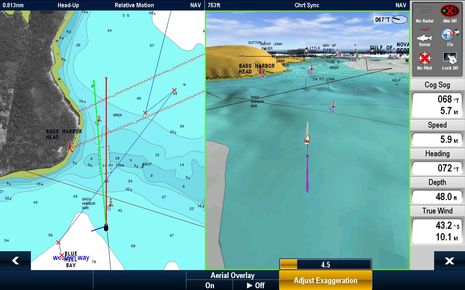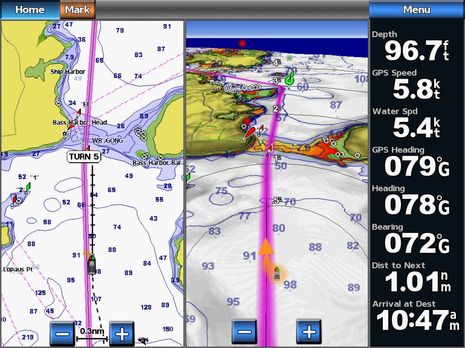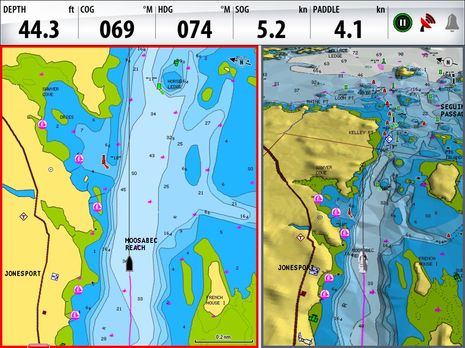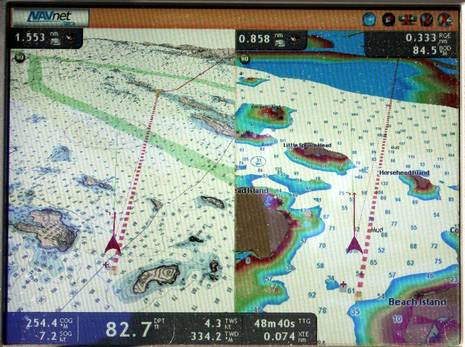MFD comparisons #3, chart plotting in 3D part 1

If I can miss major ways that MFDs display currents and tides, lord only knows how much I might mess up a comparison of 3D charting. There are so many aspects to 3D presentation, and virtually no bench mark as to what is right. In fact, I'm running the Raymarine E140 Wide screen shot first because it illustrates one of the few things that's clearly wrong, I think, which is to put the vessel on center, so that you get the most detail of the waters you've already passed through. But Raymarine has long offered good Look Ahead features in its 2D chart presentation (as seen in the left window, set at 2/3rds ahead), and I know that 3D Look Ahead is high on its list of planned software updates...
I suspect that the TMI (too much information) on the horizon, and the lack of spot soundings, may also be on Ray's list, but the latter is one of many 3D aspects that are subjective. I watched a friend nearly swoon when he saw Garmin's Mariner 3D with hazardous depths marked in reds and oranges, and that was before Garmin added the spot soundings option seen below. I like seeing those numbers myself, but understand that they're not really necessary and may be viewed as noise by other navigators. I wish Garmin would make zooming in and out of its various 3D views possible, not just tilting, but also understand that it's made many friends by keeping things simple... The 3D view on the Simrad NSE -- only available when using a Navionics Platinum card -- can be zoomed and tilted, and I'm getting fond of it. But I'm also aware that some boaters don't care for 3D at all. Where do you stand? And if you do use it, what do you like about your MFD's presentation and how can it be improved?...
The 3D view on the Simrad NSE -- only available when using a Navionics Platinum card -- can be zoomed and tilted, and I'm getting fond of it. But I'm also aware that some boaters don't care for 3D at all. Where do you stand? And if you do use it, what do you like about your MFD's presentation and how can it be improved?... And of course let's not forget NavNet 3D. Furuno has gone further than anyone with 3D, and it's my current favorite in this regard. I even like upside down raster charts in 3D. I'm going to spend more time comparing 2D and 3D charting across the MFDs, but I'm also writing magazine articles on the subject right now, and would appreciate any and all feedback.
And of course let's not forget NavNet 3D. Furuno has gone further than anyone with 3D, and it's my current favorite in this regard. I even like upside down raster charts in 3D. I'm going to spend more time comparing 2D and 3D charting across the MFDs, but I'm also writing magazine articles on the subject right now, and would appreciate any and all feedback.

 Share
Share
Ben ......
Great topic .....
I'm posting two videos that cover most of the 3D functionality of the Garmin 740. This functionality is the same found in the 6000/7000 series and is much different than the 4000/5000 series.
I prefer the 3D displays ..... they add a lot to SA.
In the Marines Eye View using the 700/6000/7000 series there are two distinct chart choices Classic/Chart. You'll see both. I like the integration of XM Weather/sonar in the 3D displays.
I've installed a couple of the new Simrad units and I must say they are cutting edge. The functionality is very well integrated and flows easily once you understand the matrix.
As with any of these units the more you use them the more familiar you become with all the functions and capabilities. Users have to be aware use leads to unit proficiency. I always tell my clients you'll lose proficency if you don't use your toys on a regular basis ..... they are perishable skills for sure.
Here are the videos ... 1st inshore 2nd offshore.
Great discussion.
Inshore
Offshore
Tom